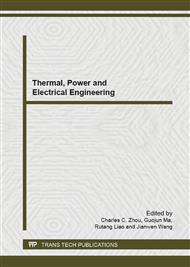[1]
Cao Yi-jia, Tao Jia, Wang Guang-zeng, Jiang Quan-yuan, Zhang Lin, and Wang Hai-feng, in: Research Progress on Interaction and Coordinated Control among FACTS Controllers, Proceedings of the CSU-EPSA, Vol. 20, No. 1, pp.1-6, Feb. (2008).
Google Scholar
[2]
Yao Feng, in: Research on Interaction Analysis of SVC and TCSC Controllers in Power Systems, " June. (2009).
Google Scholar
[3]
Su Jian-she, Chen Chen, in: Coordinated Design of SVC and TCSC for Transient Stability Enhancement, Journal of Shang Hai JiaoTong University, Vol. 37, No. 9, Sep. (2003).
Google Scholar
[4]
Zou Zhen-yu, Jiang Quan-yuan, Zhang Peng-xiang, Li Liang, Cao Yi-jia, and Wang Hai-feng, in: Coordinated Design of TCSC and SVC Controller Based on Multi-objective Evolutionary Algorithm, Automation of Electric Power Systems, V01. 29, No. 6, pp.60-65, Mar. 25, (2005).
Google Scholar
[5]
Liu Qing and Wang Zeng-ping, in: Coordinated Control of Multiple FACTS Based on Pareto Collaborative Optimization Algorithm, Electric Power Automation Equipment, Vol. 29, No. 7, Jul. (2009).
Google Scholar
[6]
Mats Larsson and Christian Rehtanz, in: Increase of Transfer Capability Through OPF一based Wide Area Control of FACTS, Automation of Eleetric Power Systems, Vol. 29, No. 6, pp.35-41, Aug. 25, (2005).
Google Scholar
[7]
Chang J and Chow J H, in: Time-Optimal Series Capacitor Control for Damping Interarea Modes in Interconnected Power Systems, IEEE Trans on PWRS, 1997, 12(1): 215~221.
DOI: 10.1109/59.574942
Google Scholar
[8]
David B and Fogel, in: An Introduction to Simulated Evolutionary Optimi-zation[J], IEEE Trans on Neural Networks, 1994, 5(1): 3~11.
Google Scholar
[9]
Yang Xiao-ping, Zhang Qiang, Xue Bin and Wang Lei, in: ulti-objective Reactive Power Optimization with Static Voltage Stability, Proceedings of the CSU-EPSA, Vol. 23, No. 1, pp.138-143, Feb. (2011).
Google Scholar
[10]
Yao Zhi-en, in: The Cntrol System of AC Electric Power Transmission Based on SVC, Modern Electronic Technology, Vol. 11, pp.93-95, (2006).
Google Scholar


